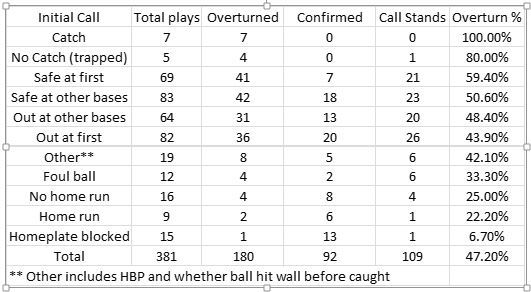The data for instant replay presented below was obtained from the MLB. This data includes the first 381 instant replay reviews that occurred in the first 759 games played this season which represents about one-third of a season. Below are the 381 initial calls that were challenged, classified by type.

Unlike the NFL three categories define the final decision. The categories are overturned, confirmed, or the call stands. In the NFL there are only two categories, the initial call either stands or is overturned. I favor the additional category supplied by the MLB because it further classifies the reason the call was not overturned.
The MLB calculated that 2 minutes and 9 seconds was the average time needed from the time of the challenge until the final decision was rendered. As a rough estimate the MLB believes, without considering the time the manager stalls looking at the dugout, instant replay adds 1 minute 6 seconds to each game. This assumes no delay that would come with full-length arguments that would have occurred without instant replay. Remember, the two goals of instant replay were to get the call right without a meaningful increase in the time of a game. The above data seems to indicate both of these goals have been met.
The data shows the easiest call to get a correct overturn is whether a ball is caught or just trapped. Combining the two initial calls of catch and no catch we see that 11 out of 12 times these two initial calls were successfully overturned. An interesting result is the comparison between the two initial calls safe at first and out at first. Safe at first was overturned 59.6% whereas out at first was overturned only 43.9% of the time. One reason I can think of for this difference is umpires seem to have a bias for the safe call due to the fact that two of the three possibilities, runner beats or ties ball arriving at first base, favors a safe call.
On the other hand safe or out calls at other bases were overturned about the same percentage of times. This can be attributed to the fact that many of these calls involve tag plays which can easily be seen.
On the other side, the least overturned call involved the new rule that catchers cannot block homeplate. Surprisingly, of the 15 initial calls that a catcher blocked homeplate only 1 time was this call overturned. This rule was put into place to protect the catcher but it is clear that the MLB must clarify this rule. The calls of home run or no home run were overturned only 6 out of 25 times. The first and third base umpires usually have a clear view of whether the ball clears the fence or lands above a yellow line.
In watching the Mets versus Braves game on July 7, the neighborhood play at second base was challenged by the Mets. On a bunt the pitcher for the Braves threw a perfect strike to the shortstop who lifted his foot off the second base bag before receiving the throw and then threw the ball to first trying to double up the Mets batter. The initial ruling on the field was out but was then overturned by instant replay. Since the neighborhood play during a double play attempt was excluded from instant replay, this clearly was an egregious error. As it turned out it did not affect the game’s outcome. In another game a triple play resulted when a call was overturned. Another positive result for instant replay is the lack of frivolous challenges by managers. In spite of the fact that there is no penalty for getting a challenge wrong, beyond just losing the challenge, the success rate of 47.2 percent overturns is considerably higher than the close to 40 percent of the typical yearly rate in the NFL, where lost challenges cost a valuable timeout.
It will be interesting to see if these statistics change when we look at the entire 2014 season.
